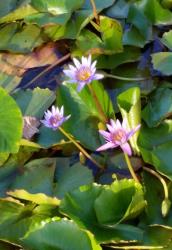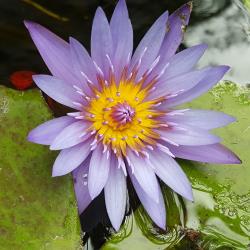Perennial, aquatic herb, with non-branching, erect, tuberous, ovoid rhizomes. Stolons absent. Brood-bodies absent. Roots adventitious. Leaves weakly dimorphic; stipules partly adnate; petiole terete, attachment narrowly peltate; floating lamina 120–300 × 100–250 mm, suborbicular, deeply cordate to slightly sagittate (lobe margins overlapping), thin and soft, glossy, glabrous, upper surface bright green; margin irregularly sinuate, crisped. Flowers 60–200 mm in diameter, held 25–40 cm above the water; sweet-scented; outer tepals 4, 40–70 mm long, triangular-ovate, apex subacute, inner surface blue, outer surface green, obscurely veined. Inner tepals numerous, 35–55 mm long, shorter than the outer tepals, elliptic-lanceolate, ovate, sky-blue, deep blue, deep pink, mauve, rarely white. Stamens numerous, 15–35 mm long, filaments yellow, anther blue, appendages conspicuous (same colour as tepals). Ovary partly free, globose with short-tapered stylar processes. Fruit globose. Seeds 1.5–1.7 × c. 1 mm, ellipsoid to semi-globose, with rows of long, hair-like papillae, dull dark olive-brown.
Distinguished by having conspicuous anther appendages, which are absent in the other two naturalised species, N. alba and N. mexicana, and the many Nymphaea ‘hardy’ cultivars in New Zealand that are bred from species of Nymphaea subgenus Nymphaea. The flower colour in Nymphaea capensis is generally blue, pink or mauve (rarely white in New Zealand), whereas it is white, flushed pink or red in N. alba and yellow in N. mexicana. The seeds are also distinctive in having rows of hair-like papillae, which differ from the uniformly hairy seeds of N. mexicana and the glabrous seeds of N. alba (although seeds have not recorded for N. capensis in New Zealand). Nymphaea capensis also can be distinguished from N. alba and ‘hardy’ cultivars by having an erect, non-branching caudex-like rhizome rather than the branching, horizontal rhizome.
The striking anther appendages in Nymphaea capensis are blue, pink or mauve (the same colour as the tepals) and are characteristic of species from Nymphaea subgenus Brachyceras, although in some Central and South American species (and a few African species) they are white. Many hybrid cultivars involving species from this subgenus are also present in New Zealand (Champion & Clayton 2001).
North Island: Southern North Island – Lake Wiritoa, near Pauri Village south of the Whanganui River.
This species and several ‘hardy’ cultivars were planted into the southern arm of Lake Wiritoa by the landowner. These have persisted for many years (C.C. Ogle, pers. comm.).
Occurs naturally in Eastern and southern Africa.
Eutrophic dune lake, 60 m a.s.l.; generally in stagnant and slow-flowing waters of lakes, ponds and streams.
CHR 518729, Ogle 3450, 31 Jan. 1999, Lake Wiritoa (cited in Heenan et al. 2002).
Flowering: late Jan.
2n = 28 (Diao et al. 2006).
By using the name Nymphaea capensis Thunb., the traditional view of Conrad (1905) is followed rather than Verdcourt (1989), who treated this species and N. caerulea Savigny (Egyptian blue lotus) as conspecific with the Asian N. nouchali Burm.f. as N. nouchali var. caerulea (Savigny) Verdc.








